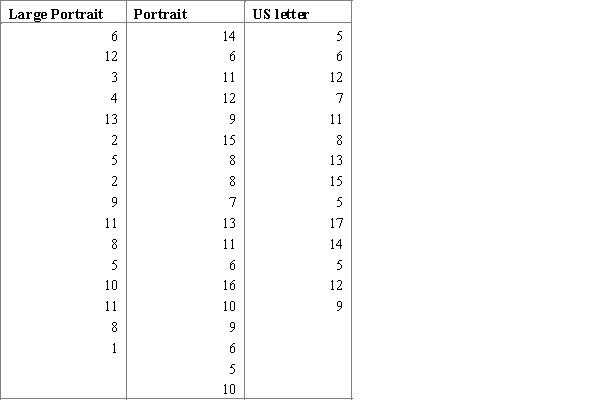When issuing a textbook, there is always a number of defective copies. The publishing house conducts a study to determine whether the number of defective copies depends on the format of the textbook. For the study, three random samples of textbook editions for the different book sizes were generated: a large portrait, a portrait, and a US letter, each of is the editions has approximately equal number of copies. The number of defective copies for each edition is indicated in the table below.  Carry out an ANOVA F test and interpret the results using the 95% confidence level.
Carry out an ANOVA F test and interpret the results using the 95% confidence level.
A)  ,
,  ,
,  , and p-value is less than 0.05.We reject the null hypothesis and can conclude that the average number of defective copies is not the same for the different textbook formats.
, and p-value is less than 0.05.We reject the null hypothesis and can conclude that the average number of defective copies is not the same for the different textbook formats.
B)  ,
,  ,
,  , and p-value is greater than 0.05.We don't reject the null hypothesis and can conclude that the average number of defective copies is the same for the different textbook formats.
, and p-value is greater than 0.05.We don't reject the null hypothesis and can conclude that the average number of defective copies is the same for the different textbook formats.
C)  ,
,  ,
,  , and p-value is less than 0.05.We reject the null hypothesis and can conclude that the average number of defective copies is not the same for the different textbook formats.
, and p-value is less than 0.05.We reject the null hypothesis and can conclude that the average number of defective copies is not the same for the different textbook formats.
D)  ,
,  ,
,  , and p-value is greater than 0.05.We don't reject the null hypothesis and can conclude that the average number of defective copies is the same for the different textbook formats.
, and p-value is greater than 0.05.We don't reject the null hypothesis and can conclude that the average number of defective copies is the same for the different textbook formats.
Correct Answer:
Verified
Q1: A course work of a student is
Q3: A researcher wants to know if people
Q4: The two main human blood group systems
Q5: A researcher wants to know if people
Q6: At a large construction website, a construction
Q7: A recruitment agency provides a study of
Q8: The two main human blood group systems
Q9: A graduate student of the college conducted
Q10: A researcher wants to find out if
Q11: Before releasing a new product, a small
Unlock this Answer For Free Now!
View this answer and more for free by performing one of the following actions

Scan the QR code to install the App and get 2 free unlocks

Unlock quizzes for free by uploading documents